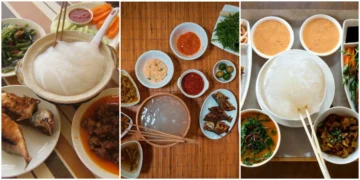Egypt—a land of ancient wonders, vibrant culture, and a rich tapestry of culinary traditions—offers a food heritage that has been shaped over millennia. Among its many celebrated dishes, one stands out as the best food of Egypt: Koshari. This hearty, humble, and flavorful dish is a perfect representation of Egypt’s resourcefulness and diverse influences. A beloved staple from bustling Cairo street stalls to family dining tables across the country, Koshari combines simple ingredients—rice, lentils, pasta, and chickpeas—into a comforting medley that is topped with a tangy tomato sauce and crispy fried onions. More than just a meal, Koshari is a culinary narrative that tells the story of modern Egypt, blending indigenous produce with hints of colonial legacy, and a spirit of innovation that has sustained generations.
Why Koshari Is the Best Food of Egypt?

Koshari’s widespread popularity in Egypt is no accident—it is a dish that epitomizes the “make-do” ingenuity that has long characterized Egyptian cooking. At its heart, Koshari is a celebration of balance and contrast. The hearty combination of rice and lentils provides a rich, satisfying base, while the addition of pasta offers a pleasant textural variation. Chickpeas add protein and subtle earthiness, and the entire dish is elevated by a spicy, vinegar-infused tomato sauce that cuts through the creaminess with a bright, tangy kick. Topped with crispy fried onions, each bite delivers a satisfying crunch that perfectly contrasts with the soft, comforting ingredients below.
For many Egyptians, Koshari is more than a simple comfort food—it is a reminder of the collective spirit and resilience of a people who have, for generations, transformed basic staples into a dish that feeds both body and soul. Often enjoyed as a filling lunch or dinner on busy days, Koshari is emblematic of the nation’s ability to create something extraordinary from modest means, reflecting both the history of resourcefulness and the evolving palate of modern Egypt.
Key Ingredients of Koshari
- Rice: Long-grain white rice, cooked until fluffy, forms the neutral canvas that absorbs the flavors of the other components.
- Lentils: Brown or green lentils, simmered until tender, contribute a creamy, earthy element that balances the dish. Their soft texture pairs perfectly with the rice.
- Pasta: Small pasta shapes, such as macaroni or ditalini, provide a delightful textural contrast. They are cooked separately and added later to maintain their bite.
- Chickpeas: These protein-rich legumes add substance and a slightly nutty flavor to the mix, enhancing the dish’s nutritional value.
- Tomato Sauce: The sauce is the soul of Koshari—a zesty, spiced blend of tomatoes, vinegar, garlic, and a secret mix of spices that gives the dish its characteristic tang and depth.
- Crispy Fried Onions: Thinly sliced onions, deep-fried until golden and crunchy.
- Seasonings and Herbs: Common seasonings include salt, pepper, and sometimes cumin or coriander, while a splash of vinegar and a pinch of chili powder elevate the overall flavor profile.
Preparation of Koshari (Best Food of Egypt)

-
Cooking the Base Components: The process begins with the independent preparation of rice, lentils, and pasta. The rice is rinsed to remove excess starch and cook until just fluffy. Lentils are soaked (if needed) and simmered until tender but not mushy. Pasta is cooked al dente to preserve a firm bite.
-
Preparing the Tomato Sauce: In a large saucepan, finely chopped garlic and onions are sautéed in a modest amount of oil. Chopped tomatoes are added along with a blend of spices such as cumin, coriander, and a dash of chili powder. A splash of vinegar introduces a tangy note, while a bit of sugar balances the acidity.
-
Frying the Onions: Thinly sliced onions are deep-fried in oil until they are crispy and golden.
-
Layering and Assembling: To assemble Koshari, a generous portion of rice is placed on a serving dish. It is topped with a layer of lentils and a scattering of pasta and chickpeas. The rich tomato sauce is then drizzled evenly over the top, ensuring that every spoonful contains a balance of all components. Finally, the crispy fried onions are liberally sprinkled on top, adding the finishing touch of crunch and flavor.
-
Serving: Koshari is typically served hot, often accompanied by extra vinegar or chili sauce.
What Makes Koshari Unique?
Koshari’s uniqueness lies in its versatility and its ability to represent the soul of Egyptian cuisine. It is a dish that seamlessly blends humble ingredients with vibrant flavors. It creates a meal that is both nutritious and incredibly comforting. Koshari is a one-dish wonder that is as accessible to the masses as it is cherished by connoisseurs of home cooking. Its balance of carbohydrates, proteins, and the brightness of a zesty tomato sauce makes it a complete and well-rounded meal.
Moreover, Koshari is more than just a culinary creation—it is a cultural phenomenon. Street vendors in Cairo have elevated Koshari to an art form, serving it in bustling urban centers where it has become synonymous with Egyptian identity. The communal nature of sharing Koshari, whether at a family dinner or from a busy food cart, reinforces its role as a symbol of togetherness and resilience. It is a dish that has nourished Egypt through times of plenty and scarcity alike.
History of Koshari (Best Food of Egypt)

The history of Koshari is as layered as its flavor profile. Its origins are believed to date back to the early 20th century when Egypt experienced rapid industrialization and urban migration. As people from rural areas moved to the cities, they brought with them simple, nourishing recipes that could be prepared with basic ingredients. Koshari emerged as a resourceful, economical meal that combined rice, lentils, pasta, and beans. Over time, the dish evolved with the addition of a spiced tomato sauce and crispy onions.
Historically, Koshari was a food of the working class—a meal that provided sustenance during long, laborious days. Today, it has transcended its humble beginnings to become a beloved national dish. Its evolution from a simple, makeshift meal to a celebrated culinary icon mirrors Egypt’s own journey.
Other Authentic Delicacies from Egypt
- Ful Medames: A traditional fava bean stew often served for breakfast.
- Koshary Variations: Some regions offer unique twists on the classic Koshari.
- Molokhia: A leafy green stew, sometimes served with chicken or rabbit.
- Fattah: A layered dish of rice, crispy bread, and meat, drizzled with garlic vinegar and tomato sauce.
- Basbousa: A sweet semolina cake soaked in syrup and often flavored with rose water or orange blossom water.










Discussion about this post